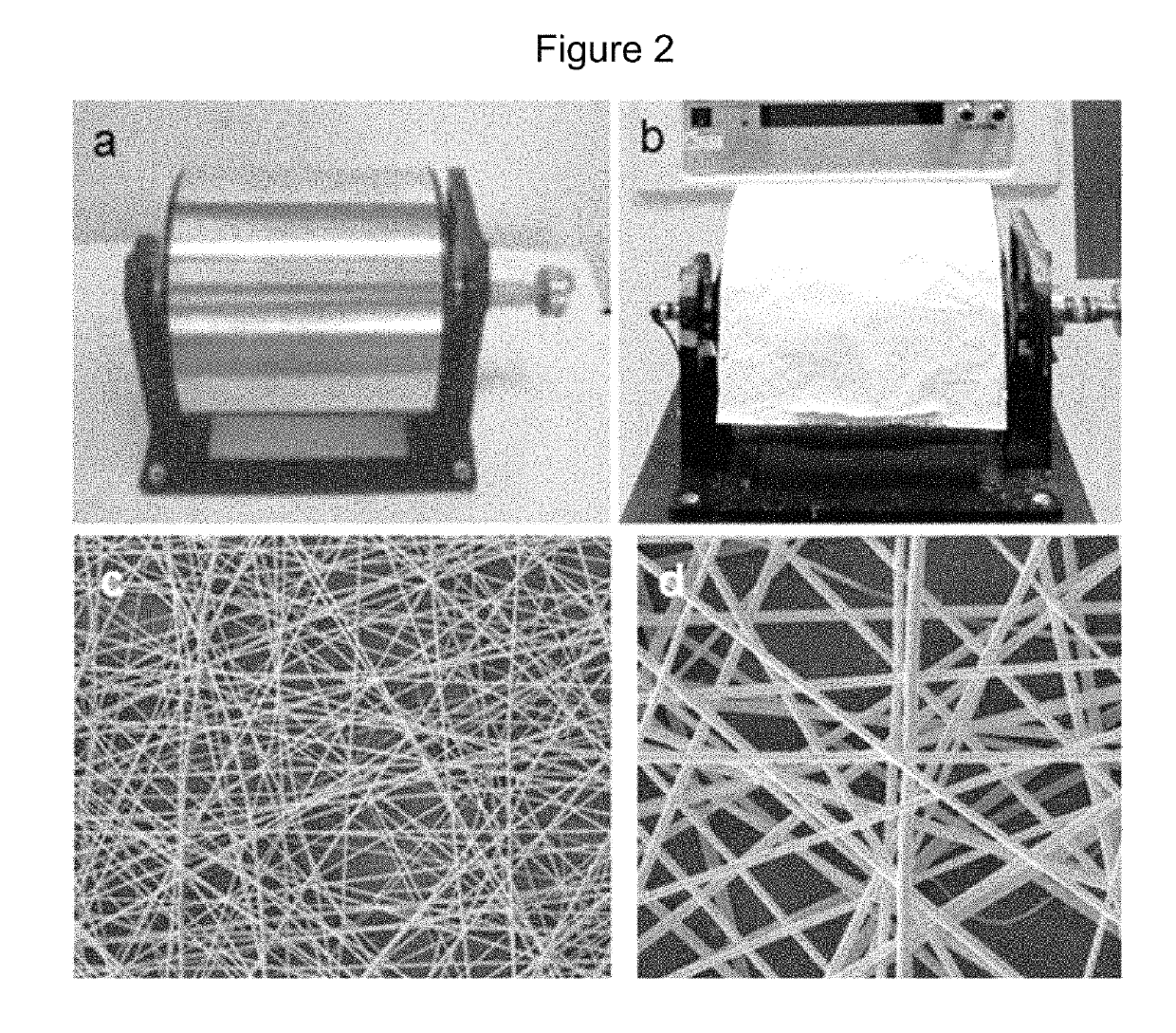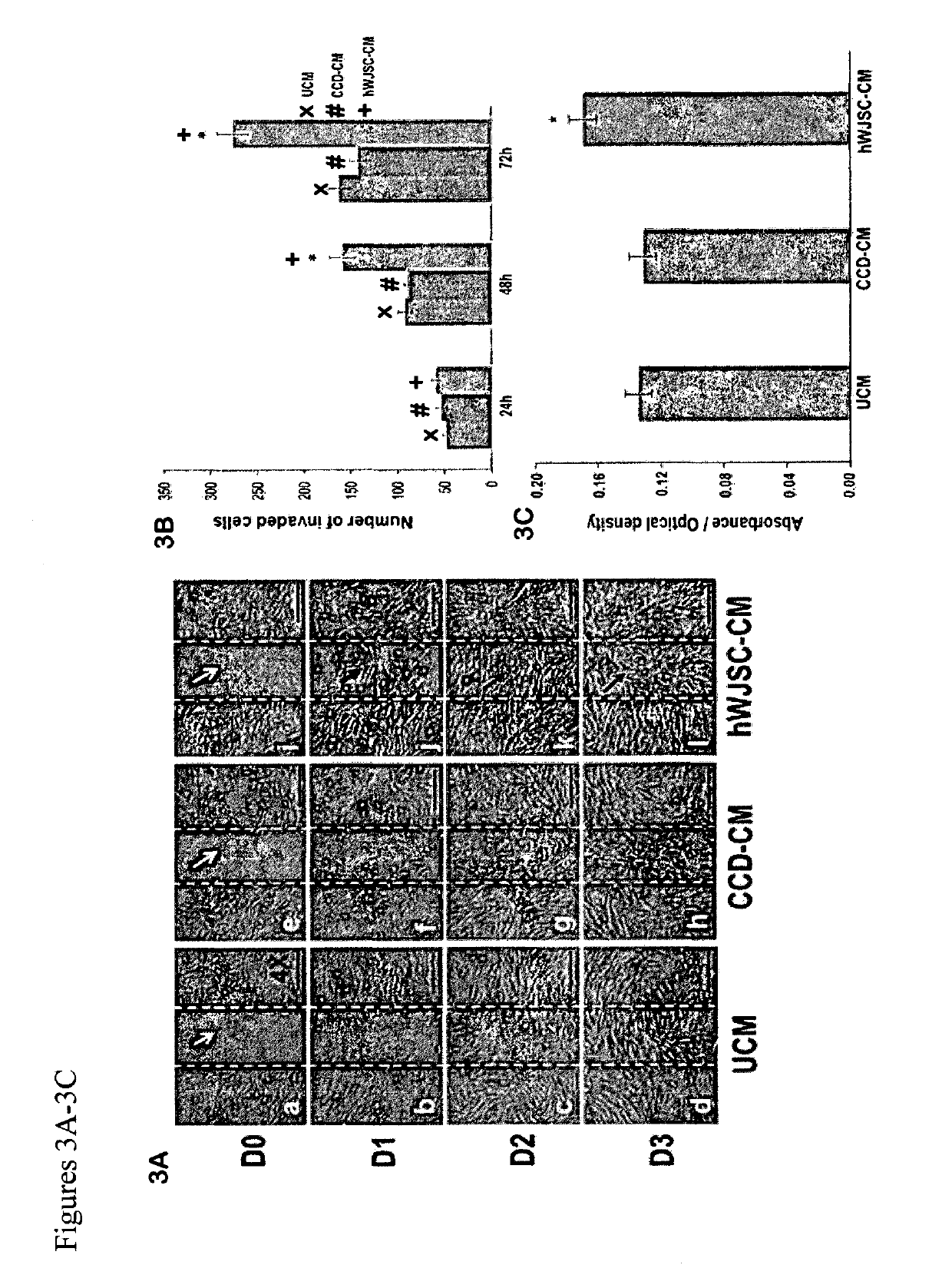Wound dressing nanomesh impregnated with human umbilical cord Wharton's jelly stem cells
a technology of nanomesh and umbilical cord, which is applied in the direction of prosthesis, drug composition, peptide/protein ingredients, etc., can solve the problems of frequent recurrence of keloids when treated, limited success of current methods for accelerating wound healing, and chronic wounds. , to achieve the effect of suppressing scar formation, suppressing scar formation, and promoting cell proliferation
- Summary
- Abstract
- Description
- Claims
- Application Information
AI Technical Summary
Benefits of technology
Problems solved by technology
Method used
Image
Examples
example 1
Methods / Materials
Experimental Designs
[0075]Two dimensional (human Wharton's jelly stem cells (hWJSCs), hWJSC-conditioned medium (hWJSCs-CM), hWJSC-primed conditioned medium (hWJSCs-PCM) or hWJSC-cell lysate (hWJSCs-CL) with no aloe vera nanomesh and three dimensional (hWJSCs, hWJSC-CM, hWJSC-PCM, or hWJSC-CL with aloe vera nanomesh) studies were carried out in vitro and in vivo in animal models. For the in vitro studies, linear scratches were made on skin fibroblast monolayers grown in Petri dishes to mimic wounds (conventional scratch assay (Linag et al., Nature Protocols, 2:329-333 (2007)). Morphological changes, proliferation rates, collagen, elastin and genomic assays were carried out on the scratched monolayers exposed to hWJSCs, hWJSC-CM, hWJSC-PCM, or hWJSC-CL with or without the aloe vera nanomesh. For the animal studies, straight and circular wounds were created on the dorsal skin in immunodeficient (Animal Resource Centre, Australia) and diabetic mice (Jackson Laboratories...
example 2
Human Umbilical Cord Wharton's Jelly Stem Cells and its Conditioned Medium Enhance Healing of Excisional and Diabetic Wounds
[0111]Poor healing of wounds is a challenging problem in patients and current treatments have met with limited success. This problem is growing worldwide due to an aging population and rise in diabetes and obesity. The treatment of excisional and diabetic wounds using a stem cell isolated from the human umbilical cord Wharton's jelly (hWJSC) that shares unique properties with embryonic and adult mesenchymal stem cells was evaluated. hWJSCs are non-controversial, available in abundance, hypo-immunogenic, non-tumorigenic, differentiate into keratinocytes and secrete important molecules for tissue repair. When conventional scratch-wound assays of human skin fibroblasts (CCD) were exposed to hWJSC-conditioned medium (hWJSC-CM) the skin fibroblasts at the wound edge proliferated and migrated into the wound space significantly faster and showed increased secretion of...
example 3
An Aloe Vera-Polycaprolactone Nanoscaffold Impregnated with Human Umbilical Cord Wharton's Jelly Stem Cells or its Conditioned Medium Improves Healing of Excisional and Diabetic Wounds In Vitro and In Vivo
[0143]Described herein is the use of MSCs from the Wharton's jelly of human umbilical cords (hWJSCs) that have several advantages over hBMMSCs which include painless harvest, availability in large numbers, hypoimmunogenicity, non-tumorigenicity, prolonged sternness properties in vitro and their ability to differentiate into keratinocytes. Since, as shown herein, nanoscaffolds provide three dimensional architectural patterns that mimic in vivo stem cell niches and aloe vera has antibacterial properties, the use of an aloe vera-polycaprolactone (AV / PCL) nanoscaffold impregnated with green fluorescent protein (GFP)-labeled hWJSCs (GFP-hWJSCs+AV / PCL) or its conditioned medium (hWJSC-CM+AV / PCL) was evaluated for healing of excisional and diabetic wounds in vitro and in vivo. In scratch-...
PUM
| Property | Measurement | Unit |
|---|---|---|
| time | aaaaa | aaaaa |
| thickness | aaaaa | aaaaa |
| diameter | aaaaa | aaaaa |
Abstract
Description
Claims
Application Information
 Login to View More
Login to View More - Generate Ideas
- Intellectual Property
- Life Sciences
- Materials
- Tech Scout
- Unparalleled Data Quality
- Higher Quality Content
- 60% Fewer Hallucinations
Browse by: Latest US Patents, China's latest patents, Technical Efficacy Thesaurus, Application Domain, Technology Topic, Popular Technical Reports.
© 2025 PatSnap. All rights reserved.Legal|Privacy policy|Modern Slavery Act Transparency Statement|Sitemap|About US| Contact US: help@patsnap.com



